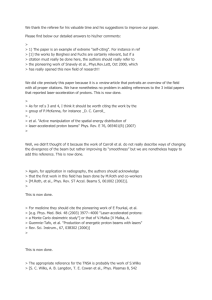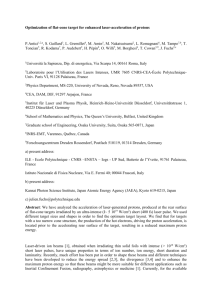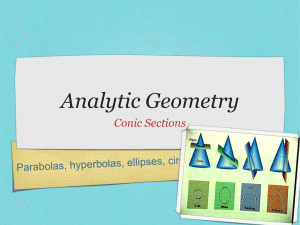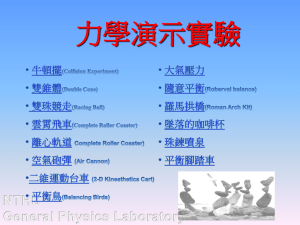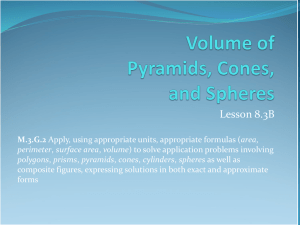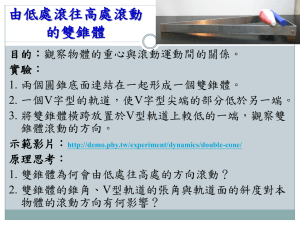Proton acceleration using circular laser polarization, foam and half
advertisement
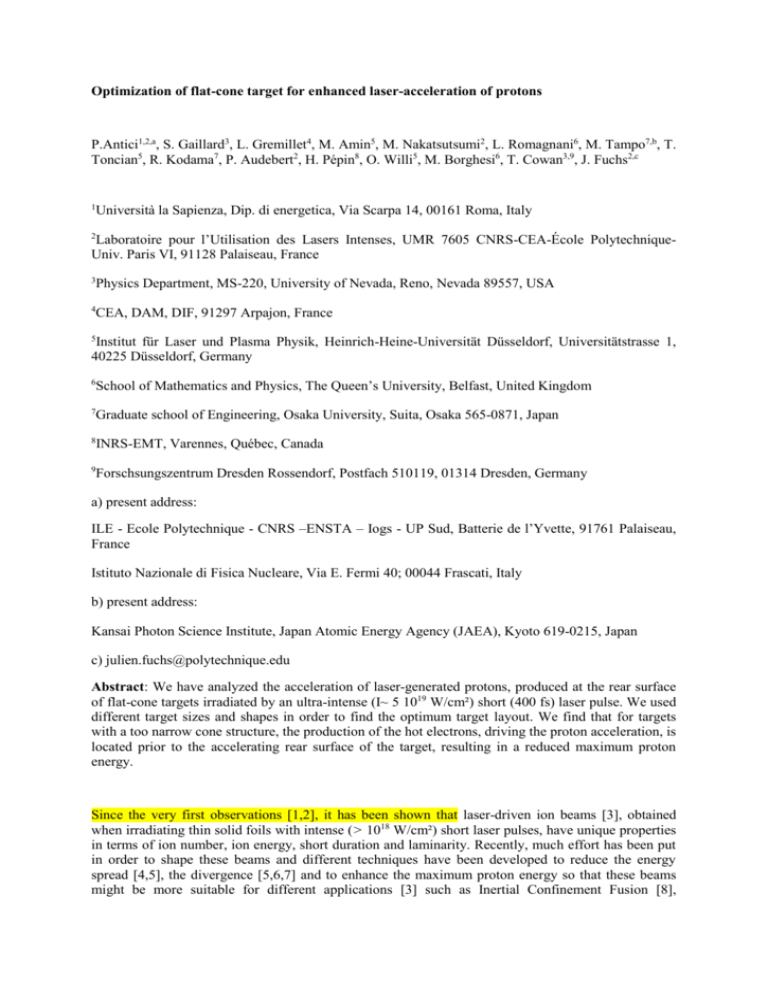
Optimization of flat-cone target for enhanced laser-acceleration of protons P.Antici1,2,a, S. Gaillard3, L. Gremillet4, M. Amin5, M. Nakatsutsumi2, L. Romagnani6, M. Tampo7,b, T. Toncian5, R. Kodama7, P. Audebert2, H. Pépin8, O. Willi5, M. Borghesi6, T. Cowan3,9, J. Fuchs2,c 1 Università la Sapienza, Dip. di energetica, Via Scarpa 14, 00161 Roma, Italy Laboratoire pour l’Utilisation des Lasers Intenses, UMR 7605 CNRS-CEA-École PolytechniqueUniv. Paris VI, 91128 Palaiseau, France 2 3 Physics Department, MS-220, University of Nevada, Reno, Nevada 89557, USA 4 CEA, DAM, DIF, 91297 Arpajon, France 5 Institut für Laser und Plasma Physik, Heinrich-Heine-Universität Düsseldorf, Universitätstrasse 1, 40225 Düsseldorf, Germany School of Mathematics and Physics, The Queen’s University, Belfast, United Kingdom 6 7 Graduate school of Engineering, Osaka University, Suita, Osaka 565-0871, Japan 8 INRS-EMT, Varennes, Québec, Canada 9 Forschsungszentrum Dresden Rossendorf, Postfach 510119, 01314 Dresden, Germany a) present address: ILE - Ecole Polytechnique - CNRS –ENSTA – Iogs - UP Sud, Batterie de l’Yvette, 91761 Palaiseau, France Istituto Nazionale di Fisica Nucleare, Via E. Fermi 40; 00044 Frascati, Italy b) present address: Kansai Photon Science Institute, Japan Atomic Energy Agency (JAEA), Kyoto 619-0215, Japan c) julien.fuchs@polytechnique.edu Abstract: We have analyzed the acceleration of laser-generated protons, produced at the rear surface of flat-cone targets irradiated by an ultra-intense (I~ 5 1019 W/cm²) short (400 fs) laser pulse. We used different target sizes and shapes in order to find the optimum target layout. We find that for targets with a too narrow cone structure, the production of the hot electrons, driving the proton acceleration, is located prior to the accelerating rear surface of the target, resulting in a reduced maximum proton energy. Since the very first observations [1,2], it has been shown that laser-driven ion beams [3], obtained when irradiating thin solid foils with intense (> 1018 W/cm²) short laser pulses, have unique properties in terms of ion number, ion energy, short duration and laminarity. Recently, much effort has been put in order to shape these beams and different techniques have been developed to reduce the energy spread [4,5], the divergence [5,6,7] and to enhance the maximum proton energy so that these beams might be more suitable for different applications [3] such as Inertial Confinement Fusion [8], radiography [9], astrophysics or medicine [10]. Currently, for the available laser intensities, the dominant mechanism that leads to acceleration of high-energy protons in the laser forward direction occurs at the non-irradiated (rear) target surface [3]. It is driven by relativistic electrons, accelerated by the laser pulse at the laser-irradiated (front) surface, that propagate through the target and form on the rear surface an electron sheath accelerating the ions. The protons originate from contaminants that are located at the target rear surface. This acceleration mechanism is called Target Normal Sheath Acceleration (TNSA) [11]. In order to enhance this acceleration mechanism, particular attention has been paid to the target fabrication, leading to an increase of the electron generation and transport. Cone target had been identified as a good mean to concentrate hot electrons [12] and thus potentially to generate higher proton energies, although the preplasma generated by the laser pedestal is a very critical issue in order to ensure that the laser-cone coupling is efficient [13]. More complex targets, using this cone structure, have been manufactured, e.g. attaching or manufacturing a small flat foil at the end of the cone (see Figure 1), called flat-tip cones [14]. The interest for these target configurations is two-fold: (i) a potentially higher laser coupling into hot electrons [15] and (ii) a potentially geometrically confined population of hot electrons within the small flat target positioned at the cone tip, both leading to enhanced electric field within the electron sheath driving the ion acceleration [3]. These targets have shown to produce currently, using the Trident LANL laser facility, the highest available laser generated proton energies of about 67 MeV [16]. Such proton energy is similar to the one obtained in earlier experiments using simple flat foils [1], however using cone-foil targets allows to reduce the required laser energy by a factor 10 (from 800 J to 80 J) for the same proton energy. In this paper we show results, obtained at the LULI 100 TW laser, using such targets with different geometries, in order to find an optimized target configuration. The experiments were performed using the 100 TW short pulse laser at the Laboratoire pour l’Utilisation des Lasers Intenses (LULI). Laser pulses of ~20-30 J at the fundamental frequency of 0=1.056 µm (compressed down to 350 fs) were focused to a best focal spot of FWHM 6 µm yielding a maximum intensity of Imax~5 1019 W/cm2. As shown in Figure 1, all targets were irradiated at normal incidence and the laser best focus point was positioned at the end point of the cone. Pointing of the laser focal spot was done prior to every shot with a <10 µm precision. As assessed on full-energy shots, the pointing stability between alignment and shot is~15 µm. The cone tip was aligned to the same location as the laser focal spot with a precision of ~5 µm. Note that the cone targets used in this experiment are not straight angled cones as used in Ref. 12 but rather funneled cones as used in Refs. 16 and 17. As the targets were all produced by the same micro-machining or microlithography techniques, this ensures that the surface quality is the same even for the smallest targets. We mainly used as diagnostic of the accelerated proton beam radiochromic film (RCF) densitometry media [18] that allow a coarse resolution of the accelerated proton beam at the target rear surface. RCF were put in a stack. Due to the localized stopping power of ions into the RCFs, the spatial distribution of the protons in a given RCF layer gives the angular emission pattern at a specific interval of proton energy. 100 TW Laser Amplifier Φ=16 mm Amplifier Φ=25 mm Amplifier Φ=45 mm Diskamplifier Densities (OD=0, 0.3, 0.6) parabola Vacuum Compressor E=30 J τ=0.3 ps Focal spot~6 µm Laser Φ (a) Target RCF Chamber (b) Figure 1: a) Photograph and geometry of the flat-tip cone targets; b) Setup of the experiment. Figure 2 shows the result of three different shots performed at normal incidence using three different target geometry as indicated. The targets were made out of Au and the thickness of the flat section at the end of the cone is 10 µm. We can see that for larger cone of 90 µm attached to a foil of 300 µm we obtained the highest proton energies, around 10.5 MeV, as indicated by the 8 layers of RCF that shown proton signal. The maximum proton energy thus obtained is quite lower compared to the one produced by irradiating a flat foil of similar thickness directly with the laser without the addition of the cone (~18 MeV). When reducing the diameter of the cone to 50 µm and the foil attached to the cone to 210 µm, the maximum proton energy reduces further to 9 MeV. A significant reduction of the proton energy, and a significant disruption of the proton beam pattern, is however obtained when reducing the cone diameter to 20 µm and the attached foil to 50 µm. In that configuration, only 1 MeV protons could be obtained. As obvious from Figure 2, while for the shots using cone diameters of 90 or 50 µm the RCF show a uniform proton beam for energies > 1 MeV, for the case of 20 µm the proton beam shows high non uniformities. In order to get a better insight in the results and to investigate laser-cone interaction physics, we look at the result of simulations performed using the PIC code CALDER and using similar laser parameters as in the experiment [13]. We consider two simulation cases, using the same cone as in Figure 2c), and corresponding to two scale lengths of preplasma (the preplasma being in exponentially increasing density ramp of variable scale-length p) at the surface of the flat foil that would be generated by the energy preleading the main laser pulse. The cone have 30° full angle, 200 aperture, 4.80 thick walls, attached to a 9.50 thick foil. The material is made of mobile Al5+ ions, with maximum electron density ne = 100nc and initial temperature Te = 1 keV. The laser pulse has the following characteristics: Imax = 1019 Wcm-2, 280 fs FWHM (sin2) temporal profile and 160 FWHM (gaussian) transverse profile. The first simulation case corresponds to a small preplasma with p =1 µm. The second simulation corresponds to a more realistic scale-length p = 7 m adapted to the ASE of the LULI laser facility. Figure 3a) shows the hot electron kinetic energy density of the simulation of the small preplasma. We can see that the electron kinetic energy is mostly located at the foil attached to the cone, i.e. the foil at the rear surface of which the acceleration process of ions takes place, generating therefore efficient proton acceleration at the target surface. Figure 3b) shows the case of the longer preplasma. As one can see, the electron kinetic energy is mostly concentrated upstream within the cone, and not at the foil surface as in Figure 3a). As electron heating occurs in a wide region of subcritical plasma inside the cone, the absorption surface being moved further outward, the angularly spread electrons get more diluted near the target rear side. The rear-side energy density and fast electron density are observed to drop by factors ~ 0.5 and ~ 0.3, respectively, compared to the small preplasma case. Moreover, fragmentation of the forward electron flux arises at larger scale than in the short-gradient case. All this results in a lower accelerating electric field within the electron sheath at the flat target surface. This justifies the worse proton beam obtained in the RCFs of Figure 2c): the preplasma does not allow an efficient production of hot electrons within the confined cone geometry. Other experiments [13] performed at the LULI laser facility using frequency-doubled laser pulses void of ASE and therefore of preplasma formation within the cones have further confirmed these results. Emax=10.5 MeV 300 µm (a) 90 µm 210 µm Emax=9 MeV 50 µm Emax=1 MeV 30 µm (b) (c) 20 µm Figure 2: Three shots using three different target geometries: a) with a cone of neck diameter 90 µm attached to a flat target of 300 µm diameter, b) with a cone of neck diameter of 50 µm and flat target of 210 µm diameter and c) with a cone of neck diameter 20 µm and flat foil of 30 µm diameter. All shots were using a laser of intensity I= 5 1019 W/cm² at normal incidence. Since this cone geometry could not be exploited efficiently using the laser at the fundamental frequency, we explored to possibility of performing shots in an “inverse-cone” configuration. In this case, the laser irradiates directly the foil that is attached to a cone (having with different diameter size), see Figure 4). The idea here is to see if we could still take advantage of the limited target surface, compared to a large flat target, in order to confine the electrons. The material of the target was still Au and had a thickness of 10 µm. This time, as shown in Figure 4.a), when using a large diameter cone of 90 µm at its smaller end, we obtain as maximum energy 17.3. MeV. This energy corresponds to that we obtain shooting directly on a large (mm size) flat foil of the same thickness. The cone structure therefore has no influence on the proton acceleration mechanism and the limited mass of the overall target does not also seem to play a role, probably because the cone is long (200 µm), longer than the sheath extension as measured on a large flat target [19]. When choosing a smaller cone diameter, e.g. 40 µm at its smaller end, we obtain much lower proton energies (5 MeV) and a less smoother proton beam. Possible scenarios to explain this would be that (i) in such a narrow target the electric fields generated by the hot electrons on the inner walls of the cone target deflected at large angle the protons, similarly as in [5] or (ii) edge effects within the cone could destroy the uniformity of the electrostatic field on irradiated target rear side. In summary, testing the possibility to use flat-tip cone targets showed the critical importance of reducing the level of energy preleading the main pulse in order to avoid producing the hot electrons upstream within the cone and not at its tip. Reverse target configurations were also tested but did not yield enhanced proton acceleration, probably due to too strong deflecting fields produced within the conical structure when using too narrow cones. (a) (b) Figure 3: Two different simulations [13] using the code CALDER and showing the laser interaction with the cone target under two different conditions: a) with a large cone geometry b) with a narrow cone geometry. 200 µm 90 µm Proton beam 200 µm 40 µm (a) 200 µm Proton beam 300 µm Emax=17 MeV Similar to the same thickness flat foil shot in the same laser conditions Emax=5.5 MeV 3 2 6 9 12 15 5 8 11 14 1 4 7 10 13 1 2 3 4 5 (b) Figure 4: Two different experimental conditions using the “inverse-cone-configuration”, i.e. the laser was hitting first on a flat foil attached to a cone with different diameters: a) an initial cone diameter of 90 µm expanding to 200 µm and b) an initial cone diameter of 40 µm expanding to 200 µm. We acknowledge the expert support of the LULI laser team. This work was supported by grant E1127 from Région Ile-de-France and UNR grant DE-FC08-01NV14050 and the projects ELI and SPARX-FEL. 1 R. A. Snavely et al., Phys. Rev. Lett. 85, 2945 (2000). 2 E. Clark et al., Phys. Rev. Lett. 84, 670 (2000); A. Maksimchuk et al., Phys. Rev. Lett. 84, 4108 (2000). 3 M. Borghesi et al., Fusion Sci. Technol. 49, 412 (2006); J. Fuchs et al., C. R. Physique 10, 176 (2009). 4 B. M. Hegelich et al., Nature (London) 439, 441 (2006); H. Schwoerer et al., Nature (London) 439, 445 (2006). 5 T. Toncian et al., Science 312, 410 (2006). 6 M. Schollmeier et al,. Phys. Rev. Lett. 101, 055004 (2008). 7 D. C. Carroll et al., Phys. Rev. E 76, 065401(R) (2007). 8 M.Roth, et al., Phys. Rev. Lett. 86, 436 (2001). 9 M.Roth, et al., Phys. Rev. ST Accel. Beams 5, 061002 (2002). 10 S. Bulanov and V. Khoroshkov, Plasma Physics Reports 28, 453 (2002); E Fourkal, et al. Phys. Med. Biol. 48, 3977 (2003); V.Malka et al. Rev. Sci. Instrum. 67, 03B302 (2006). 11 S. Hatchett et al., Phys. Plasmas 7, 2076 (2000); S. C. Wilks et al., Phys. Plasmas 8, 542 (2001). 12 R. Kodama et al., Nature (London) 432, 1005, (2004); Z. Chen et al., Phys. Rev. E 71. 036403 (2005); Z. Chen et al., Phys. Rev. Lett. 96, 084802 (2006). 13 S. Baton et al., Phys. Plasmas 15, 042706 (2008). 14 K. Flippo et al., Phys. Plasmas 15, 056709 (2008). 15 Y. Sentoku et al., Phys. Plasmas 11, 3083(2004). 16 http://www.aps.org/meetings/unit/dpp/vpr2009/loader.cfm?csModule=security/getfile&pageid=19180 5 17 E. d'Humieres et al., Eur. Phys. J. Special Topics 175, 89 (2009); J. Rassuchine et al., Phys. Rev. E 79, 036408 (2009). 18 N. V. Klassen, et al., Med.Phys., 24, 1924 (1997). 19 L. Romagnani et al, Phys Rev. Lett 95, 195001 (2005); P. Antici et al., Phys. Rev. Lett. 101, 105004 (2008).
